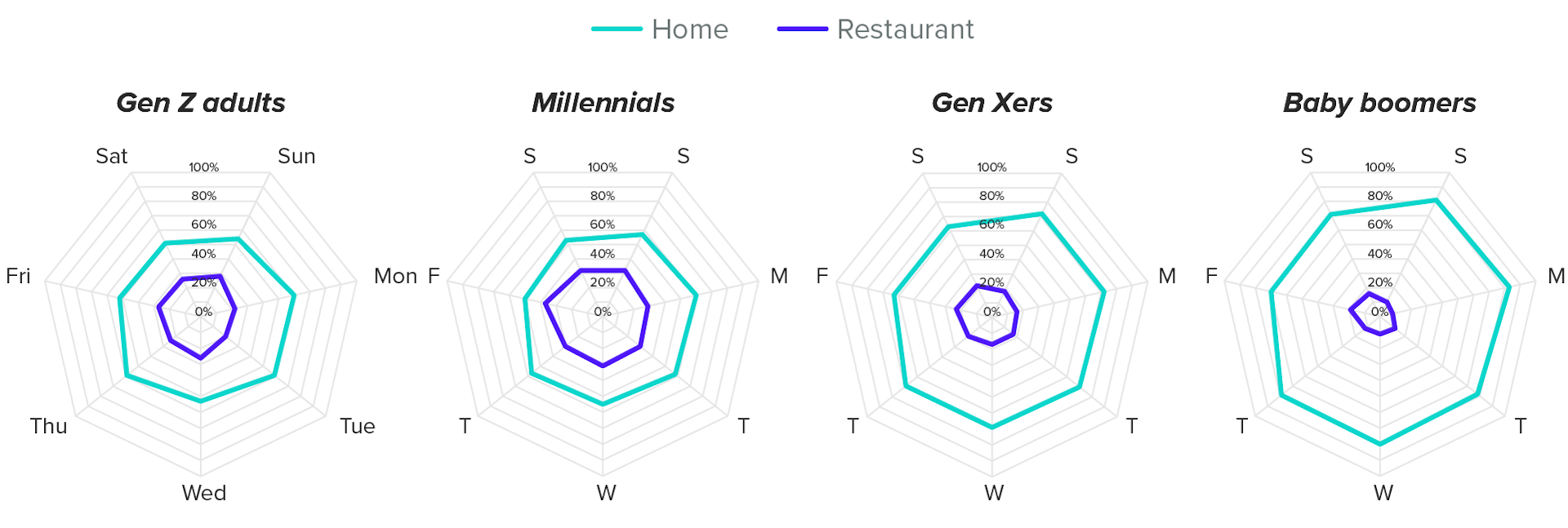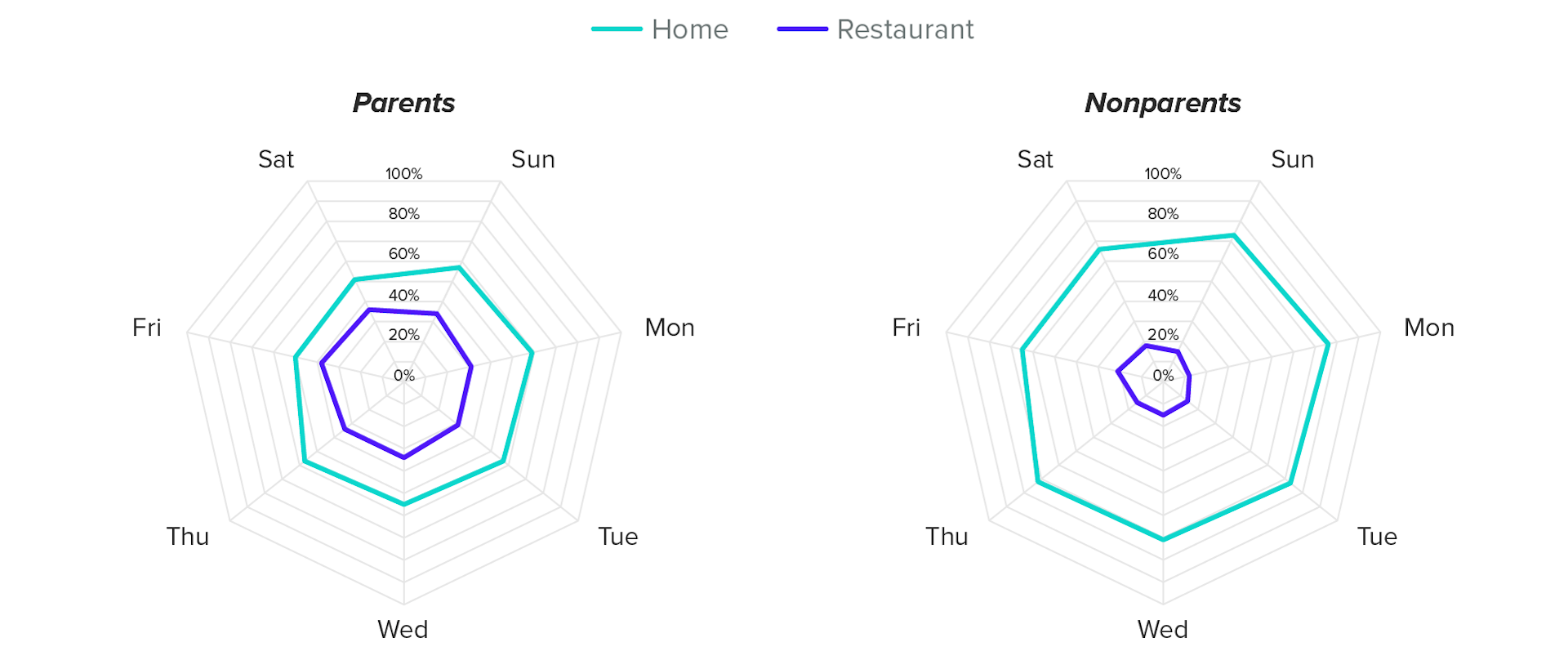When and How Consumers Are Cooking in 2023

Key Takeaways
70% of U.S. adults said they made dinner at home on Monday, 10 percentage points higher than on Friday night.
Despite the dominance of meals made at home, certain demographics like younger adults, parents and those from dual-income households are far more reliant on restaurants than others.
Eating habits are generally slow to change, but generational shifts such as Gen Zers’ and millennials’ reliance on restaurants have the potential to shake up the industry and should factor into brands’ long-term planning.
Get the latest global brand, media and marketing news and analysis delivered to your inbox every morning.
Eating and drinking behaviors are habitual, but that doesn’t mean the decisions consumers make are simple. Meals throughout the week range from slapdash weeknight dinners to leisurely weekend brunches. Accordingly, consumers’ decisions about what to eat, and how to prepare it, also run the gamut, taking into account various factors and needs on these different occasions.
The decisions people make vary by demographic factors that reveal who’s cooking or using restaurants the most, as well as when people are least likely to cook. It’s crucial for food & beverage brands to understand these behaviors so they can optimize content, focus on key consumer groups and ensure relevant positioning in the marketplace.
How people are eating meals
No matter the demographic, one thing is clear: Most meals are sourced from home. That’s true for every day of the week and all three main meals. Affordability, control over ingredients or flavors, and health are the top reasons for making meals at home, either from scratch or from packaged or prepared items.
Although still largely made at home, dinner plans tend to shift the most between weeknights and weekends. U.S. adults are 10 percentage points more likely to make dinner at home on Monday than on Friday. It’s clear that consumers are more likely to cook at home for weeknight meals and shift toward more restaurant meals as the work week winds down. Unlike cooking at home, craveable foods and experiences are what drive restaurant dining. Being in the mood for a specific food or wanting to treat oneself or one’s family are the top reasons for eating at or ordering from restaurants.
How Americans Eat Breakfast, Lunch and Dinner
For breakfast and lunch, the shares of U.S. adults who make meals at home or get them from restaurants are relatively steady throughout the week, although there is a slight brunch effect on Saturday and Sunday, when consumers are about 3 percentage points more likely to eat breakfast at restaurants.
Skipping meals is also a relatively consistent behavior from one day to the next. The meal U.S. adults are most likely to skip is breakfast: Roughly 1 in 5 say they forgo it each day of the week. Women, Gen Xers and baby boomers, as well as suburban and rural consumers, are more likely to skip the morning meal. Just over 1 in 7 U.S. adults skip lunch each day of the week. Skipping dinner, on the other hand, is far less common.
Consumers are slightly less likely to cook dinner from scratch this year compared with last
There was a decrease in the share of consumers who said they cooked dinner from scratch on any given night of the week compared with last year. The share of U.S. adults who said they cooked dinner at home from scratch was 3 to 6 points lower throughout the week compared with February 2022, when Morning Consult fielded the same survey question.
Restaurant usage, in turn, has increased. Seasonality may have something to do with it, as these surveys were fielded in different months and people generally prefer to stay home in the colder winter months. The coronavirus is also a factor. In February 2022, the number of cases in the United States was coming down from a steep omicron surge that peaked in mid-January. The pandemic greatly shaped consumers’ dining out habits, and lingering concerns continued to dampen restaurant demand at that time.
U.S. Adults Are More Likely to Cook Dinner From Scratch at the Start of the Week
Who’s cooking dinner most often
Who is present for a meal dictates many decisions about when and how it is prepared and eaten. More people equates to more tastes to cater to and more schedules to accommodate. In the United States, there are plenty of unique household types — 4,708 in fact, according to one authoritative analysis — that influence cooking and restaurant habits. Even in the top 10 most common household types, there’s plenty of variation that could lead to different cooking habits.
Due to different life stages, household makeup and financial situations, one of the biggest contrasts in cooking habits is generational. Baby boomers are over 20 points more likely to say they cooked dinner from scratch each night of the week than millennials, who make up the largest share of adults with kids living at home (more on parents below).
In addition to the influence of parenthood, Gen Zers and millennials formed their adult eating habits alongside a tech-enabled landscape of takeout and prepared food options and delivery services, which have helped ingrain restaurant options in their daily lives.
Younger generations may be cooking less, but that doesn’t mean they don’t like to. In fact, it appears cooking less may actually allow for more room to enjoy it. Millennials are 5 points more likely than baby boomers to say they cook because they enjoy it, while baby boomers are more likely to say they cook because they have to.
Millennials and Gen Z adults are more reliant on restaurants than their older counterparts

As mentioned above, parental status impacts cooking habits. Those without children under 18 living at home were far more likely to say they made meals at home each night. For parents, many of whom find themselves in a life stage that often requires balancing family and other personal commitments with work demands, restaurant options save both time and mental energy.
Families lean toward off-premises restaurant orders instead of dining out with kids in tow. For each day of the week, about one-quarter of parents said they got either takeout or delivery, while 1 in 10 said they ate at a restaurant for dinner.
Parents Make Fewer Meals at Home

Another factor that influences cooking habits is whether both spouses are employed. Not only do households with two working adults tend to have more income to spend at restaurants, but they also likely have less time to make meals at home. For many, work schedules that take them outside the home may elevate takeout as an easy option on the way back.
Dual-Income Households Rely on Restaurants More Than Single-Income Households

Planning meals ahead of time is a must for parents and dual-income households
Perhaps counterintuitively, the demographics that cook less at home — millennials, parents and adults from dual-income households — are the same groups that are most likely to plan meals in advance and engage in meal prep activities. Households where both partners are employed are among the most likely to say they plan all or most of their meals, with nearly 2 in 3 saying they do. For busy households, having a plan is a must. To remain relevant, brands need to offer content with an extra serving of ideas and inspiration for those meal plans — or barring that, focus on coming through in a pinch when plans go off the rails.
Emily Moquin previously worked at Morning Consult as a lead food & beverage analyst.
Related content

Around 3 in 10 U.S. Adults Are Interested in Trying Ozempic, Other GLP-1s for Weight Loss

More Than Half of Gen Z and Millennial Drinkers Are Interested in TikTok’s ‘Damp Drinking’ Trend
